Genesis of the Late Cretaceous Longquanzhan Gold Deposit in the Central Tan-Lu Fault Zone, Shandong Province, China: Constraints from Noble Gas and Sulfur Isotopes
Abstract
1. Introduction
2. Geological Background
3. Deposit Geology
4. Sampling and Analytical Methods
4.1. Sample Description
4.2. He–Ar Isotope Analyses
4.3. Sulfur Isotope Analyses
5. Results
5.1. He–Ar Isotopic Compositions
| Sample Locations | Sample | Measured Minerals | 4He (cm3 STP/g) (E−7) | 40Ar (cm3 STP/g) (E−7) | 3He/4He (Ra) | 38Ar/36Ar | 40Ar/36Ar | 40Ar*/4He | 40Ar* (%) | HeMantle(%) | Data Source |
|---|---|---|---|---|---|---|---|---|---|---|---|
| Yi’nan gold deposit | LJ-29-2 | Py | 1.80 | 2.07 | 1.12 | n.a. | 826.0 | 0.74 | 64.23 | 18.45 | [4] |
| LJ-29-5 | Py | 5.86 | 1.10 | 0.48 | n.a. | 439.4 | 0.06 | 32.75 | 7.85 | ||
| LJ-29-7 | Py | 4.33 | 2.28 | 0.27 | n.a. | 460.4 | 0.19 | 35.82 | 4.34 | ||
| TJ-2 | Py | 20.59 | 9.16 | 0.12 | 0.16 | 458.0 | 0.16 | 35.48 | 1.85 | This study | |
| TJ-8 | Py | 3.13 | 2.56 | 0.11 | 0.01 | 364.1 | 0.15 | 18.84 | 1.72 | ||
| TJ-1 | Py | 2.73 | 5.73 | 1.02 | b.d. | 454.7 | 0.74 | 35.01 | 16.81 | ||
| Qibaoshan gold deposit | QBSH-10 | Py | 44.94 | 2.78 | 0.19 | b.d. | 842.4 | 0.04 | 64.92 | 3.07 | |
| QRSH-8 | Py | 1.53 | 7.53 | 0.19 | 0.22 | 297.5 | 0.03 | 0.67 | 3.02 | ||
| Longquanzhan gold deposit | LQZ-2 | Py | 10.50 | 5.85 | 0.78 | b.d. | 577.1 | 0.27 | 48.80 | 12.85 | |
| LQZ-3 | Py | 6.18 | 5.69 | 0.17 | 0.19 | 893.6 | 0.62 | 66.93 | 2.74 | ||
| LQZ-4 | Py | 3.74 | 4.52 | 0.28 | 0.19 | 1142.4 | 0.90 | 74.13 | 4.57 | ||
| LQZ-5 | Py | 7.21 | 5.05 | 0.16 | 0.19 | 1559.1 | 0.57 | 81.05 | 2.52 | ||
| Zk5201-H64 | Py | 8.59 | 7.99 | 0.24 | n.a. | 1811.0 | 0.78 | 83.68 | 3.84 | [43] | |
| Sly-47 | Py | 0.96 | 2.81 | 0.14 | n.a. | 482.0 | 1.13 | 38.69 | 2.17 |
5.2. S Isotopic Compositions
6. Discussion
6.1. Sources of Ore-Forming Fluids and Metals
6.2. Ore Genesis and Geodynamic Setting
7. Conclusions
Author Contributions
Funding
Data Availability Statement
Acknowledgments
Conflicts of Interest
References
- Guo, P.; Santosh, M.; Li, S.R. Geodynamics of gold metallogeny in the Shandong Province, NE China: An integrated geological, geophysical and geochemical perspective. Gondwana Res. 2013, 24, 1172–1202. [Google Scholar] [CrossRef]
- Li, S.R.; Santosh, M. Metallogeny and craton destruction: Records from the North China Craton. Ore Geol. Rev. 2014, 56, 376–414. [Google Scholar] [CrossRef]
- Goldfarb, R.J.; Santosh, M. The dilemma of the Jiaodong gold deposits: Are they unique? Geosci. Front. 2014, 5, 139–153. [Google Scholar] [CrossRef]
- Liu, Y.; Santosh, M.; Li, S.R.; Guo, P. Stable isotope geochemistry and Re-Os ages of the Yinan gold deposit, Shandong Province, northeastern China. Int. Geol. Rev. 2014, 56, 695–710. [Google Scholar] [CrossRef]
- Xu, G.Z.; Zhou, R.; Wang, Y.F.; She, H.Q.; Li, B.; Du, B.M.; Song, M.C. The intrinsic factors caused the significant differences in Mesozoic mineralization between Jiaodong and Luxi areas. Geoscience 2002, 16, 9–17, (In Chinese with English Abstract). [Google Scholar]
- Li, L.; Santosh, M.; Li, S.R. The ‘Jiaodong type’ gold deposits: Characteristics, origin and prospecting. Ore Geol. Rev. 2015, 65, 589–611. [Google Scholar] [CrossRef]
- Mao, J.W.; Wang, Y.T.; Li, H.M.; Pirajno, F.; Zhang, C.Q.; Wang, R.T. The relationship of mantle-derived fluids to gold metallogenesis in the Jiaodong Peninsula: Evidence from D-O-C-S isotope systematics. Ore Geol. Rev. 2008, 33, 361–381. [Google Scholar] [CrossRef]
- Yang, J.H.; Wu, F.Y.; Wilde, S.A. A review of the geodynamic setting of large-scale Late Mesozoic gold mineralization in the North China Craton: An association with lithospheric thinning. Ore Geol. Rev. 2003, 23, 125–152. [Google Scholar] [CrossRef]
- Li, S.R.; Santosh, M. Geodynamics of heterogeneous gold mineralization in the North China Craton and its relationship to lithospheric destruction. Gondwana Res. 2017, 50, 267–292. [Google Scholar] [CrossRef]
- Zhu, R.X.; Fan, H.R.; Li, J.W.; Meng, Q.R.; Li, S.R.; Zeng, Q.D. Decratonic gold deposits. Sci. China Earth Sci. 2015, 58, 1523–1537. [Google Scholar] [CrossRef]
- Li, J.-W.; Bi, S.-J.; Selby, D.; Chen, L.; Vasconcelos, P.M.; Thiede, D.; Zhou, M.-F.; Zhao, X.-F.; Li, Z.-K.; Qiu, H.-N. Giant Mesozoic gold provinces related to the destruction of the North China Craton. Earth Planet. Sci. Lett. 2012, 349–350, 26–37. [Google Scholar] [CrossRef]
- Tan, J.; Wei, J.H.; He, H.Y.; Su, F.; Li, Y.J.; Fu, L.B.; Zhao, S.Q.; Xiao, G.L.; Zhang, F.; Xu, J.F.; et al. Noble gases in pyrites from the Guocheng-Liaoshang gold belt in the Jiaodong province: Evidence for a mantle source of gold. Chem. Geol. 2018, 480, 105–115. [Google Scholar] [CrossRef]
- Chai, P.; Hou, Z.Q.; Zhang, Z.Y. Geology, fluid inclusion and stable isotope constraints on the fluid evolution and resource potential of the Xiadian gold deposit, Jiaodong Peninsula. Resour. Geol. 2017, 67, 341–359. [Google Scholar] [CrossRef]
- Gao, S.; Rudnick, R.L.; Yuan, H.L.; Liu, X.M.; Liu, Y.S.; Xu, W.L.; Ling, W.L.; Ayers, J.; Wang, X.C.; Wang, Q.H. Recycling lower continental crust in the North China Craton. Nature 2004, 432, 892–897. [Google Scholar] [CrossRef] [PubMed]
- Cai, Y.C.; Fan, H.R.; Santosh, M.; Liu, X.; Hu, F.F.; Yang, K.F.; Liu, Y. Evolution of the lithospheric mantle beneath the southeastern North China Craton: Constraints from mafic dikes in the Jiaobei terrain. Gondwana Res. 2013, 24, 601–621. [Google Scholar] [CrossRef]
- Zhang, H.F. Destruction of ancient lower crust through magma underplating beneath Jiaodong Peninsula, North China Craton: U-Pb and Hf isotopic evidence from granulite xenoliths. Gondwana Res. 2012, 21, 281–292. [Google Scholar] [CrossRef]
- Tan, J.; Wei, J.H.; Audétat, A.; Pettke, T. Source of metals in the Guocheng gold deposit, Jiaodong Peninsula, North China Craton: Link to early Cretaceous mafic magmatism originating from Paleoproterozoic metasomatized lithospheric mantle. Ore Geol. Rev. 2012, 48, 70–87. [Google Scholar] [CrossRef]
- Ma, L.; Jiang, S.Y.; Hofmann, A.W.; Dai, B.Z.; Hou, M.L.; Zhao, K.D.; Chen, L.H.; Li, J.W.; Jiang, Y.H. Lithospheric and asthenospheric sources of lamprophyres in the Jiaodong Peninsula: A consequence of rapid lithospheric thinning beneath the North China Craton? Geochim. Cosmochim. Acta 2014, 124, 250–271. [Google Scholar] [CrossRef]
- Ma, L.; Jiang, S.Y.; Hofmann, A.W.; Xu, Y.G.; Dai, B.Z.; Hou, M.L. Rapid lithospheric thinning of the North China Craton: New evidence from cretaceous mafic dikes in the Jiaodong Peninsula. Chem. Geol. 2016, 432, 1–15. [Google Scholar] [CrossRef]
- Deng, J.; Liu, X.; Wang, Q.; Dilek, Y.; Liang, Y. Isotopic characterization and petrogenetic modeling of Early Cretaceous mafic diking-Lithospheric extension in the North China craton, eastern Asia. Geol. Soc. Am. Bull. 2017, 129, 1379–1407. [Google Scholar] [CrossRef]
- Shi, W.J.; Wei, J.H.; Tan, J.; Li, Y.J.; Fu, L.B.; Li, H.; Zhao, S.Q.; Tian, N. Late Early Cretaceous gold mineralization in Tan-Lu fault zone: Evidence from Rb-Sr isotopic dating of pyrite from Longquanzhan gold deposit. Earth Sci. J. China U Geosci. 2014, 39, 325–340, (In Chinese with English Abstract). [Google Scholar] [CrossRef]
- Li, Y.L.; Qiu, J.S.; Liu, L. Geochronology and geochemistry of sodic volcanic rocks from Shenquan in Tancheng County, Shandong Province: Implications for unravelling the nature of mantle source and petrogenesis. Acta Petrol. Miner. 2012, 31, 783–798, (In Chinese with English Abstract). [Google Scholar]
- Wang, X.F.; Li, Z.J.; Chen, B.L. Tan-Lu Fault Belt; Geology Publishing House: Wuhan, China, 2000; pp. 12–308. (In Chinese) [Google Scholar]
- Wang, R.; Shi, W.; Zhang, X.; Tang, D.; Chen, H.; Xu, Q.; Xu, Z. Magmatic Activity Characteristics and Its Coupling Relationship with Regional Tectonics in the Eastern Depression of North Yellow Sea Basin, Eastern China. Earth Sci. J. China U Geosci. 2017, 42, 587–600, (In Chinese with English Abstract). [Google Scholar] [CrossRef]
- Zhang, J.; Li, W.; Wu, Z.P.; Li, C.R.; Yang, B.; Zhang, X.Q. Structural Characteristics of Tan-Lu Fault Zone in South Area of Bohai Sea and Its Control on Basin Structure. Earth Sci. J. China U Geosci. 2017, 42, 1549–1564, (In Chinese with English Abstract). [Google Scholar] [CrossRef]
- Shi, W.J. The Late Mesozoic Tectonic-Magmatic Evolution Process in the Yishu Fault Zone and Adjacent Regions, Shandong Province: Implication for Gold Mineralization. Ph.D. Thesis, China University of Geosciences, Wuhan, Hubei, 2014. (In Chinese with English Abstract). [Google Scholar]
- Shen, Q.H.; Zhang, Z.Q.; Xu, H.F. Study on the isochron age in the Archean granulite terrains of Yishui, Shandong Province. Acta Geol. Sin. 1994, 1, 17–19, (In Chinese with English Abstract). [Google Scholar]
- Wang, S.J.; Wan, Y.S.; Song, Z.Y.; Yang, E.X.; Wang, W.; Dong, C.Y.; Liu, L. Stratigraphic division and formation era of Taishan Group in Luxi area: Evidence of zircon SHRIMP U-Pb dating. Miner. Resour. Geol. 2012, 28, 15–23, (In Chinese with English Abstract). [Google Scholar]
- Qiu, J.S.; Liu, L.; Li, Y.L. Geochronology and geochemistry of potassic and sodic volcanic rocks in Tangtou basin, Shandong Province: Implications for lithospheric thinning beneath the North China Craton. Acta Petrol. Sin. 2012, 28, 1044–1056, (In Chinese with English Abstract). [Google Scholar]
- Liu, D.Y.; Jian, P.; Kröne, A.; Xu, S.T. Dating of prograde metamorphic events deciphered from episodic zircon growth in rocks of the Dabie–Sulu UHP complex, China. Earth Planet. Sci. Lett. 2006, 250, 650–666. [Google Scholar] [CrossRef]
- Su, S.G.; Zhou, X.R.; Gu, D.L. Characteristics, ages and geneses of charnockites in Yishui area, Shandong Province. Earth Sci. J. China U Geosci. 1999, 24, 58–62, (In Chinese with English Abstract). [Google Scholar]
- Shen, Q.H.; Zhao, Z.R.; Song, B.; Song, H.X. Geology, petrochemistry and SHRIMP zircon U-Pb dating of the Mashan and Xueshan granitoids in Yishui County, Shandong Province. Geol. Rev. 2007, 53, 180–186, (In Chinese with English Abstract). [Google Scholar] [CrossRef]
- Zhao, Z.R.; Song, H.X.; Shen, Q.H.; Song, B. Geological and geochemical characteristics and SHRIMP U-Pb zircon dating of the Yinglingshan granite and its xenoliths in Yishui County, Shandong, China. Geol. Bull. China 2008, 27, 1551–1558, (In Chinese with English Abstract). [Google Scholar]
- Jahn, B.M.; Liu, D.Y.; Wan, Y.S.; Song, B.; Wu, J.S. Archean crustal evolution of the Jiaodong Peninsula, China, as revealed by zircon SHRIMP geochronology, elemental and Nd-isotope geochemistry. Am. J. Sci. 2008, 308, 232–269. [Google Scholar] [CrossRef]
- Lan, T.G.; Fan, H.R.; Santosh, M.; Hu, F.F.; Yang, K.F.; Yang, Y.H.; Liu, Y.S. Early Jurassic high-K calc-alkaline and shoshonitic rocks from the Tongshi intrusive complex, eastern North China Craton: Implication for crust-mantle interaction and post-collisional magmatism. Lithos 2012, 140–141, 183–199. [Google Scholar] [CrossRef]
- Gu, H.O.; Xiao, Y.; Santosh, M.; Li, W.Y.; Yang, X.; Pack, A.; Hou, Z. Spatial and temporal distribution of Mesozoic adakitic rocks along the Tan-Lu fault, Eastern China: Constraints on the initiation of lithospheric thinning. Lithos 2013, 177, 352–365. [Google Scholar] [CrossRef]
- Wang, Y.; Fan, H.R.; Hu, F.F.; Lan, T.G. Ore-forming fluids and metallogenesis of the Qibaoshan Cu-Au deposit in the Wulian County, Shandong Province, China. Acta Petrol. Sin. 2008, 24, 2029–2036, (In Chinese with English Abstract). [Google Scholar]
- Baptiste, P.J.; Fouquet, Y. Abundance and isotopic composition of helium in hydrothermal sulfides from the East Pacific Rise at 13 °N. Geochim. Cosmochim. Acta 1996, 60, 87–93. [Google Scholar] [CrossRef]
- Ye, X.R.; Tao, M.X.; Yu, C.A.; Zhang, M.J. Helium and neon isotopic compositions in the ophiolites from the Yarlung Zangbo River, southwestern China: The information from deep mantle. Sci. China Ser. D Earth Sci. 2007, 50, 801–812. [Google Scholar] [CrossRef]
- Tan, J.; Wei, J.H.; Li, Y.J.; Fu, L.B.; Li, H.M.; Shi, W.J.; Tian, N. Origin and geo- dynamic significance of fault-hosted massive sulfide gold deposits from the Guocheng-Liaoshang metallogenic belt, easternJiaodong Peninsula: Rb-Sr dating, and H-O-S-Pb isotopic constraints. Ore Geol. Rev. 2015, 65, 687–700. [Google Scholar] [CrossRef]
- Mamyrin, B.A.; Tolstikhin, I.N. Helium Isotopes in Nature, 1st ed.; Amsterdam Press: Amsterdam, The Netherlands, 1984; 237p. [Google Scholar]
- Mark, D.F.; Stuart, F.M.; de Podesta, M. New high-precision measurements of the isotopic composition of atmospheric argon. Geochim. Cosmochim. Acta 2011, 75, 7494–7501. [Google Scholar] [CrossRef]
- Hu, H.B.; Sun, A.Q.; Niu, S.Y.; Wang, B.D.; Li, Y.P. Helium and argon isotopic com positions of the Longquanzhan gold deposit in the Yi-Shu fault zone and their geological implications. Chin. J. Geochem. 2007, 26, 46–51. [Google Scholar] [CrossRef]
- Zhang, L.C.; Zhou, X.H.; Ding, S.J. Mantle-derived fluids involved in large-scale gold mineralization, Jiaodong district, China: Constraints provided by the He-Ar and H-O isotopic systems. Int. Geol. Rev. 2008, 50, 472–482. [Google Scholar] [CrossRef]
- Li, J.; Song, M.C.; Liang, J.L.; Jiang, M.Y.; Li, S.Y.; Ding, Z.J.; Su, F. Source of ore-forming fluids of the Jiaojia deeply seated gold deposit: Evidences from trace elements and sulfur-helium-argon isotopes of pyrite. Acta Petrol. Sin. 2020, 36, 297–313, (In Chinese with English Abstract). [Google Scholar] [CrossRef]
- Torgersen, T.; Kennedy, B.M.; Hiyagon, H.; Chiou, K.Y.; Reynolds, J.H.; Clarke, W.B. Argon accumulation and the crustal degassing flux of 40Ar in the Great Artesian Basin, Australia. Earth Planet. Sci. Lett. 1989, 92, 43–56. [Google Scholar] [CrossRef]
- Winckler, G.; Aeschbach-Hertig, W.; Kipfer, R.; Botz, R.; Rubel, A.P.; Bayer, R.; Stoffers, P. Constraints on origin and evolution of Red Sea brines from helium and argon isotopes. Earth Planet. Sci. Lett. 2001, 184, 671–683. [Google Scholar] [CrossRef]
- Qiu, J.S.; Wang, D.Z.; Ren, Q.J.; Zhang, Z.Z. Physical-chemical conditions for mineralization of the Qibaoshan gold-copper deposit and its metallogeny in Wulian country, Shandong Province. Miner. Resour. Geol. 1994, 39, 12–18, (In Chinese with English Abstract). [Google Scholar]
- Li, K.; Gu, X.X.; Dong, S.Y. Isotopic geochemistry of Yinan Au-Cu-Fe deposit in Shandong Province. Miner. Depos. 2009, 28, 93–103, (In Chinese with English Abstract). [Google Scholar] [CrossRef]
- Burnard, P.G.; Hu, R.Z.; Turner, G.; Bi, X.W. Mantle, crustal and atmospheric noble gases in Ailaoshan gold deposit, Yunnan province, China. Geochim. Cosmochim. Acta 1999, 63, 1595–1604. [Google Scholar] [CrossRef]
- Burnard, P.G.; Polya, D.A. Importance of mantle derived fluids during granite associated hydrothermal circulation: He and Ar isotopes of ore minerals from Panasqueira. Geochim. Cosmochim. Acta 2004, 68, 1607–1615. [Google Scholar] [CrossRef]
- Hu, R.Z.; Burnard, P.G.; Bi, X.W.; Zhou, M.F.; Pen, J.T.; Su, W.C.; Wu, K.X. Helium and argon isotope geochemistry of alkaline intrusion-associated gold and copper deposits along the Red River–Jinshajiang fault belt, SW China. Chem. Geol. 2004, 203, 305–317. [Google Scholar] [CrossRef]
- Hu, R.Z.; Burnard, P.G.; Bi, X.W.; Zhou, M.F.; Pen, J.T.; Su, W.C.; Zhao, J.H. Mantle-derived gaseous components in ore-forming fluids of the Xiangshan uranium deposit, Jiangxi province, China: Evidence from He, Ar and C isotopes. Chem. Geol. 2009, 266, 86–95. [Google Scholar] [CrossRef]
- Kendrick, M.A.; Burnard, P. Noble gases and halogens in fluid inclusions: A journey through the Earth’s crust. In The Noble Gases as Geochemical Tracers, Advances in Isotope Geochemistry; Burnard, P., Ed.; Springer: Berlin/Heidelberg, Germany, 2013; pp. 319–369. [Google Scholar] [CrossRef]
- Stuart, F.M.; Burnard, P.G.; Taylor, R.P. Resolving mantle and crustal contributions to ancient hydrothermal fluids: He-Ar isotopes in fluid inclusions from Dae Hwa W-Mo mineralisation, South Korea. Geochim. Cosmochim. Acta 1995, 59, 4663–4673. [Google Scholar] [CrossRef]
- Ballentine, C.J.; Burnard, P.G. Production, release and transport of noble gases in the continental crust. Rev. Mineral. Geochem. 2002, 47, 481–538. [Google Scholar] [CrossRef]
- Stuart, F.M.; Turner, G.; Duckworth, R.C.; Fallick, A.E. Helium isotopes as tracers of trapped hydrothermal fluids in ocean-floor sulfides. Geology 1994, 22, 823–826. [Google Scholar] [CrossRef]
- Xu, S.; Nakai, S.; Wakita, H. Mantle-derived noble gases in natural gases from Songliao Basin, China. Geochim. Cosmochim. Acta 1995, 59, 4675–4683. [Google Scholar] [CrossRef]
- Simmons, S.F.; Sawkins, F.J.; Schlutter, D.J. Mantle-derived helium in two Peruvian hydrothermal ore deposits. Nature 1987, 329, 429–432. [Google Scholar] [CrossRef]
- Kyser, T.K. Stable isotopes in the continental lithospheric mantle. In Continental Mantle; Menzies, M., Ed.; Oxford University Press: Oxford, MS, USA, 1990; pp. 127–156. [Google Scholar]
- Cai, Y.C.; Fan, H.R.; Santosh, M.; Hu, F.F.; Yang, K.F.; Li, X.H. Decratonic gold mineralization: Evidence from the Shangzhuang gold deposit, eastern North China Craton. Gondwana Res. 2018, 54, 1–22. [Google Scholar] [CrossRef]
- Xie, C.L. The Late Mesozoic Magmatism along the South Segment of the Tan-Lu Fault Zone and Its Implication for Lithospheric Thinning. Ph.D. Thesis, Hefei University of Technology, Hefei, Anhui, 2008. (In Chinese with English Abstract). [Google Scholar]
- Dai, L.Q.; Zheng, Y.F.; Zhao, Z.F. Termination time of peak decratonization in North China: Geochemical evidence from mafic igneous rocks. Lithos 2016, 240, 327–336. [Google Scholar] [CrossRef]
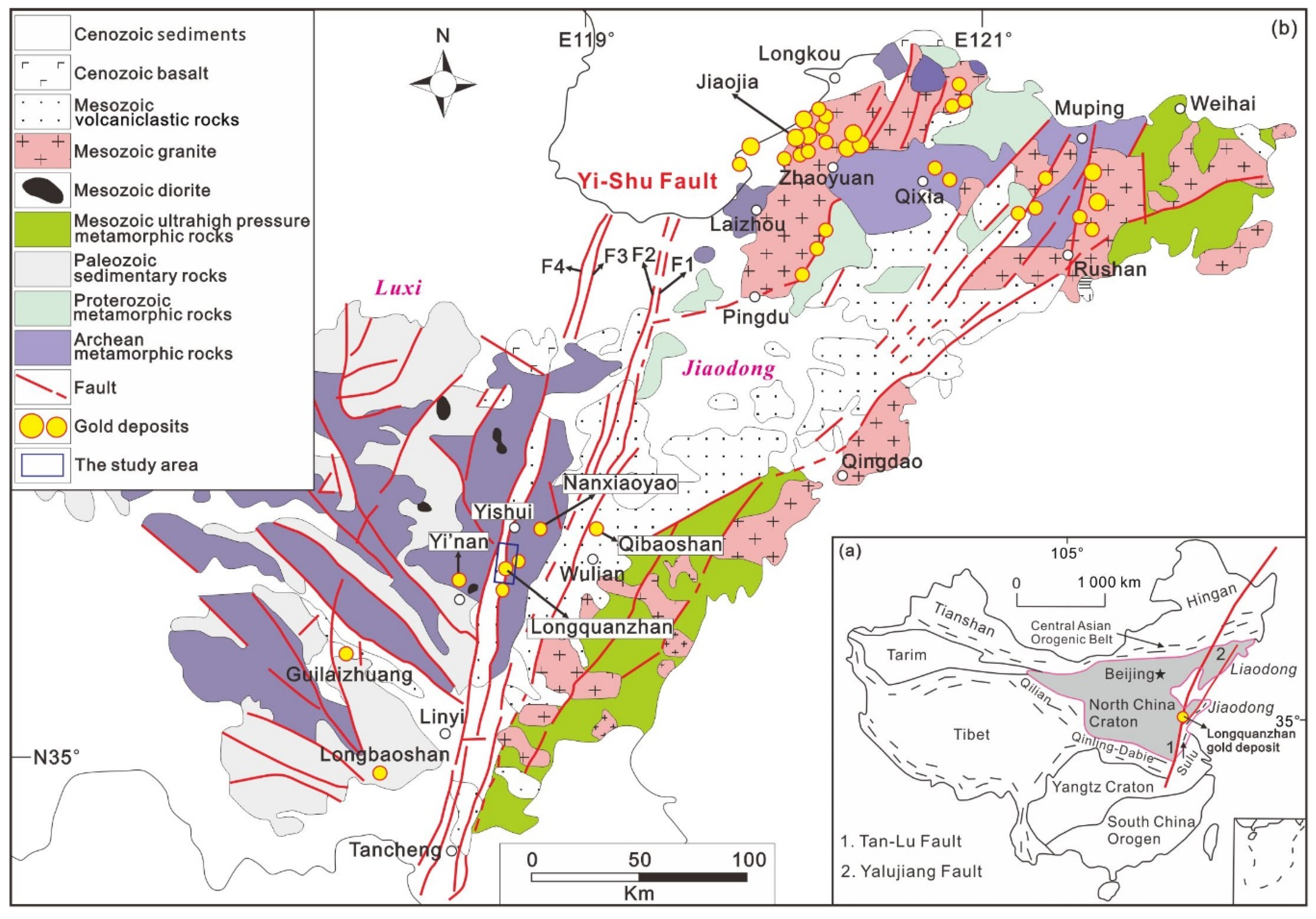

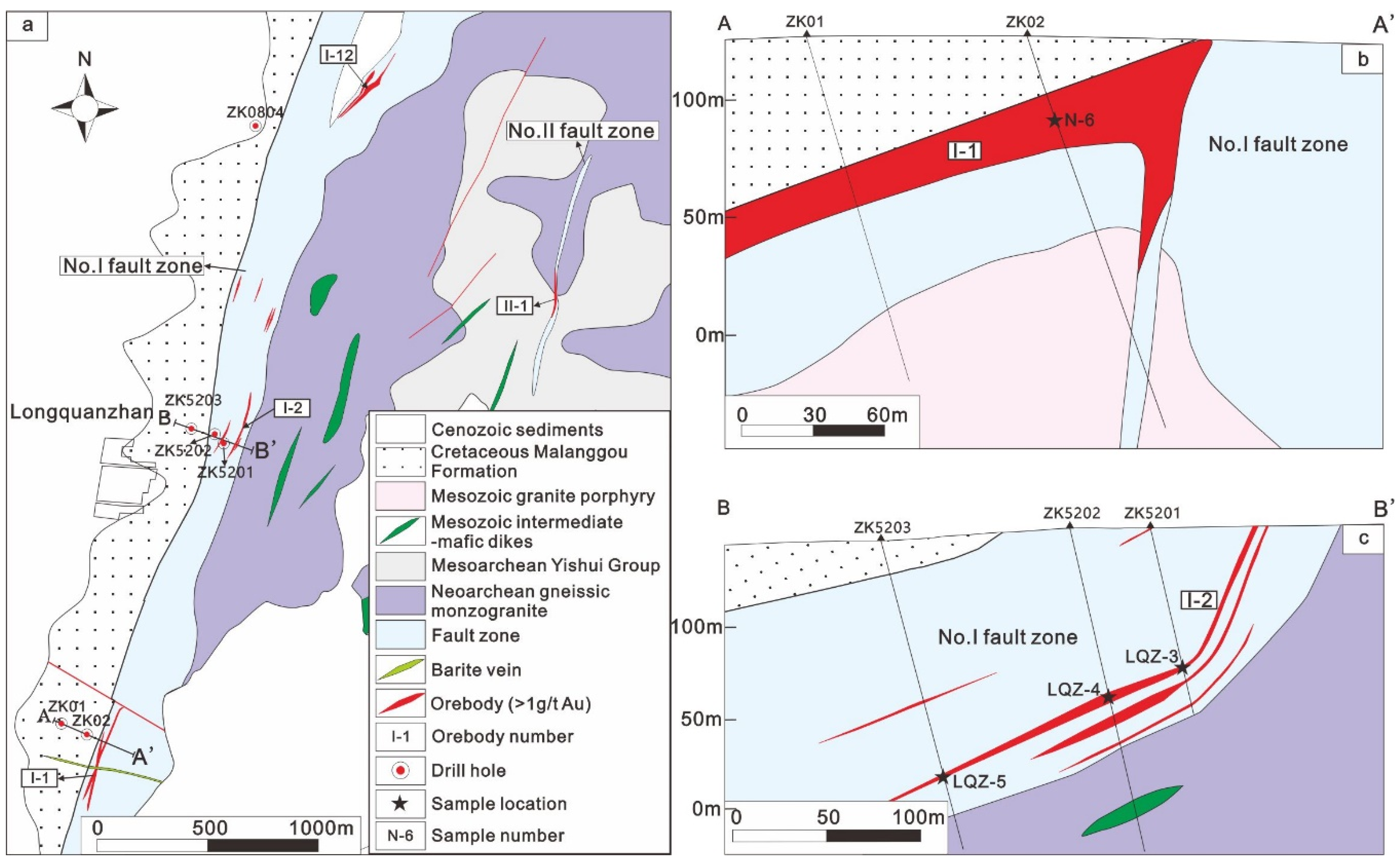
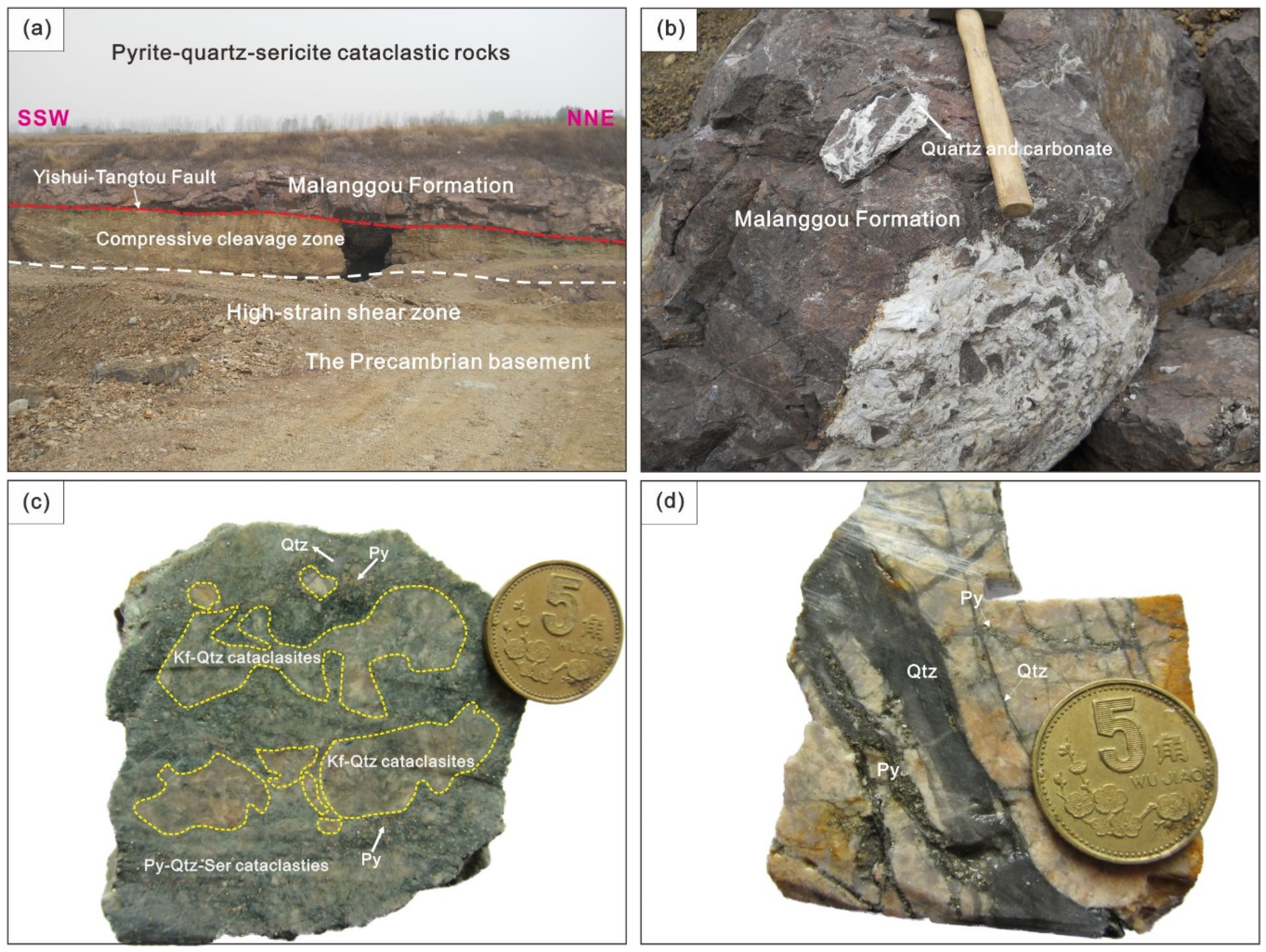
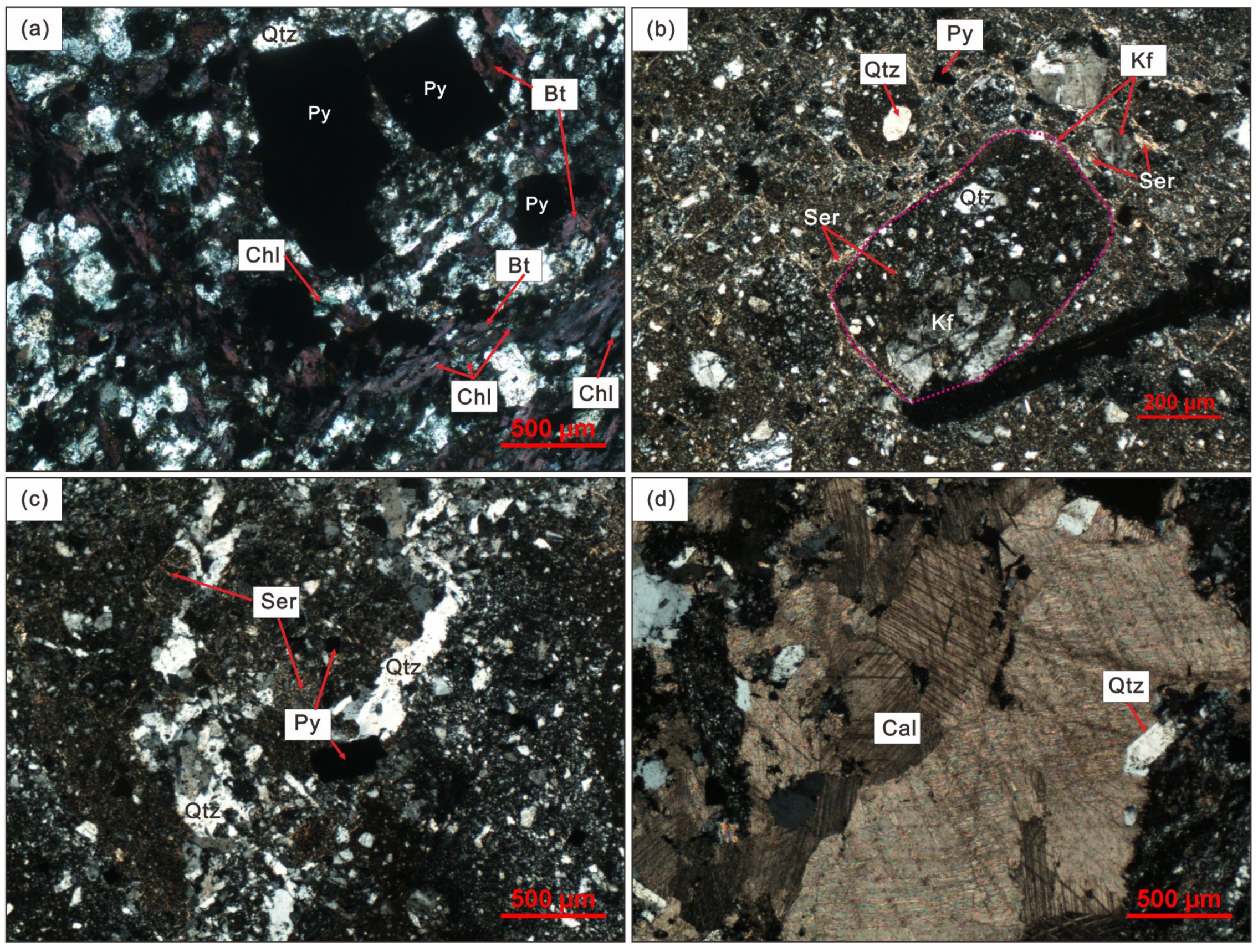

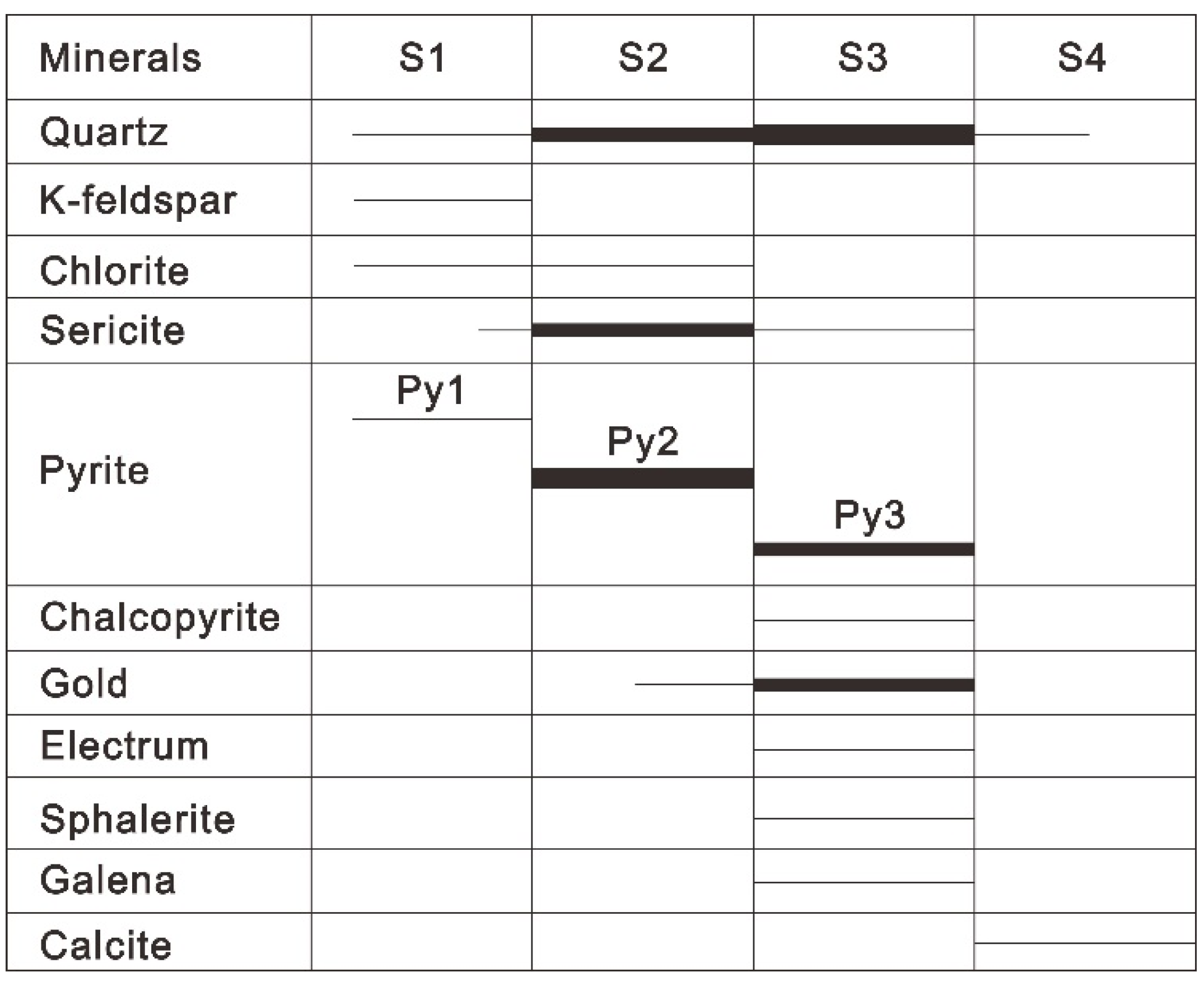
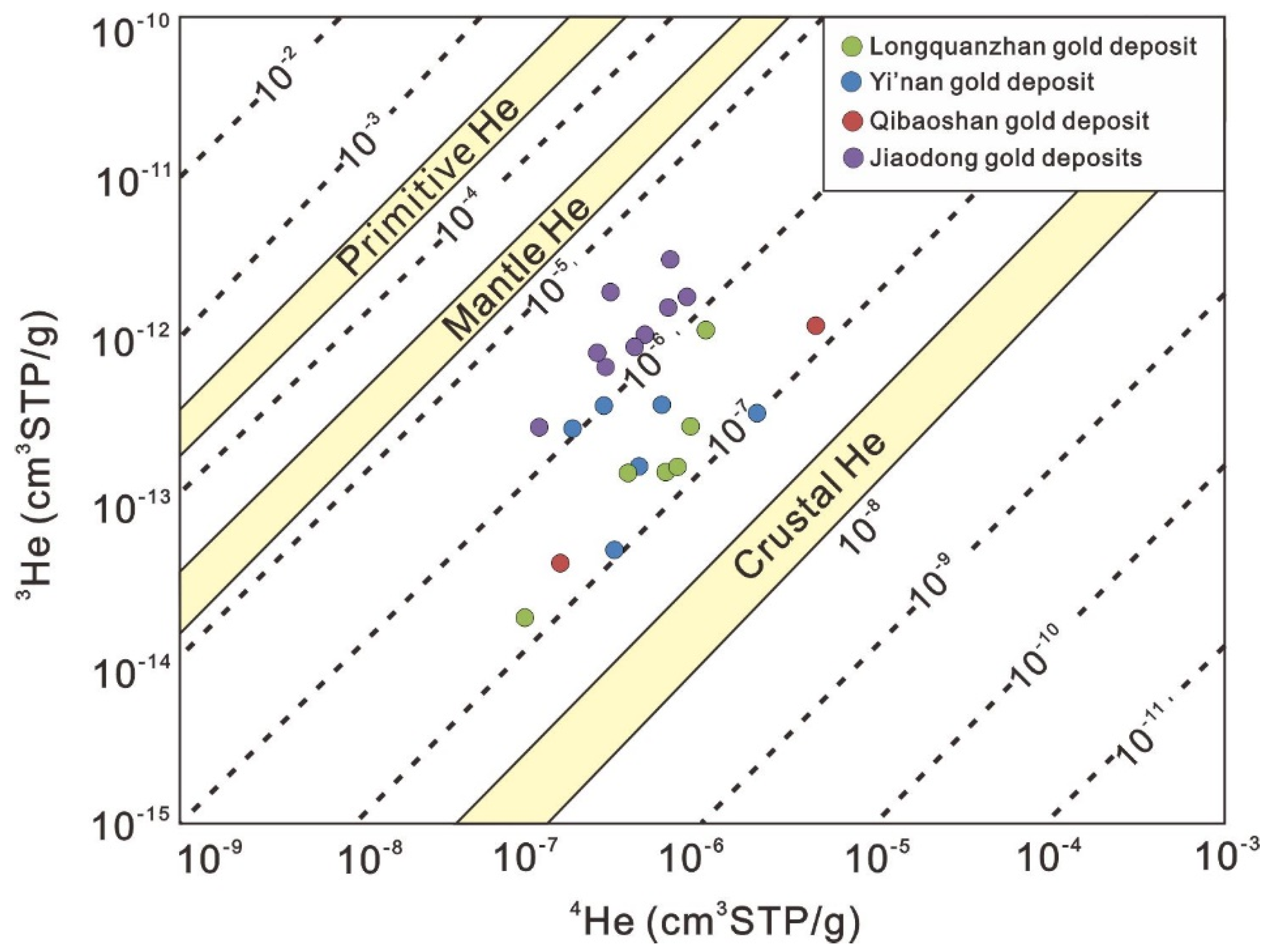

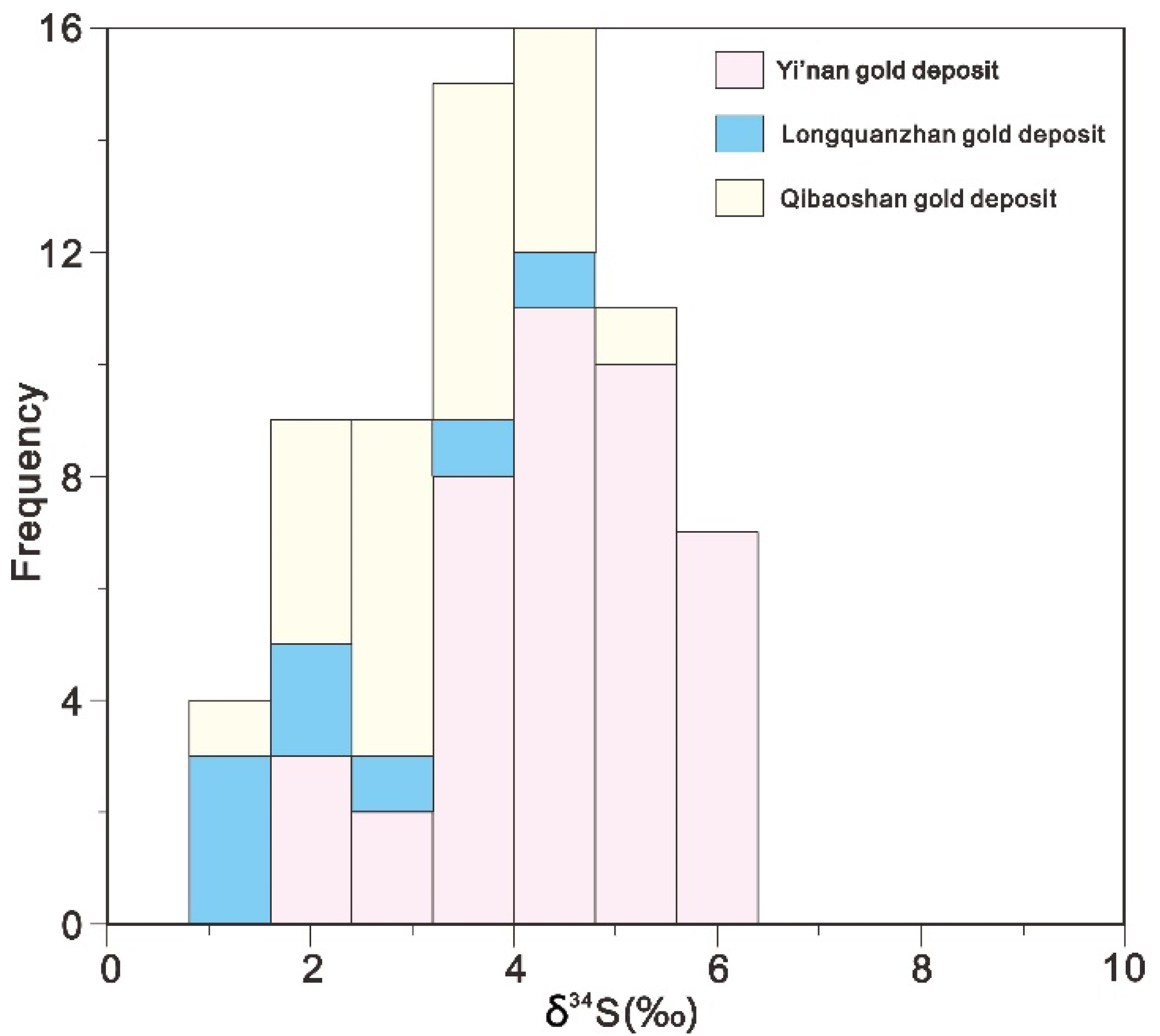

| Sample | Sulfide Assemblage | Mining Area | Lithology | Mineralization Stage | Sampling Location |
|---|---|---|---|---|---|
| N-6 | Py (35%) + Gn (7%) + Sp (5%) | Longquanzhan 1 | Gneissic monzogranite | Gold-quartz-polymetallic sulfide stage | +82 m Drill ZK02 |
| N-9 | Py (50%) + Gn (5%) + Sp (5%) | Longquanzhan 1 | Gneissic monzogranite | Gold-quartz-polymetallic sulfide stage | Drill ZK02 SE + 30 m |
| N-20 | Py (60%) | Longquanzhan 1 | Gneissic monzogranite | Quartz-sericite-pyrite stage | Drill ZK02 SE + 90 m |
| N-22 | Py (40%) + Gn (7%) + Sp (3%) | Longquanzhan 2 | Gneissic monzogranite | Gold-quartz-polymetallic sulfide stage | Drill ZK02 SE + 150 m |
| N-24 | Py (40%) + Gn (3%) + Sp (3%) | Longquanzhan 1 | Gneissic monzogranite | Gold-quartz-polymetallic sulfide stage | Drill ZK02 SE + 200 m |
| LQZ-2 | Py (30%) + Gn (6%) + Sp (4%) | Longquanzhan 2 | Amphibolite | Gold-quartz-polymetallic sulfide stage | –157 m Drill No. ZK0804 |
| LQZ-3 | Py (20%) + Gn (7%) + Sp (5%) | Longquanzhan 2 | Gneissic monzogranite | Gold-quartz-polymetallic sulfide stage | +63 m Drill No. ZK5201 |
| LQZ-4 | Py (40%) | Longquanzhan 2 | Gneissic monzogranite | Quartz-sericite-pyrite stage | +53 m Drill No. ZK5202 |
| LQZ-5 | Py (30%) + Gn(5%) + Sp(5%) | Longquanzhan 2 | Gneissic monzogranite | Gold-quartz-polymetallic sulfide stage | 0 m Drill No. ZK5203 |
| TJ-2 | Py (40%) + Cpy (10%) | Yi’nan 3 | Marble | Quartz-sulfide stage | –130 m Tunnel + CM3 |
| TJ-8 | Py (42%) + Cpy (5%) | Yi’nan 3 | Marble | Quartz-sulfide stage | –141 m Drill No.CK99-14 |
| TJ-1 | Py (43%) + Cpy (5%) | Yi’nan 3 | Marble | Quartz-sulfide stage | –138 m Drill No.CK92-24 |
| QRSH-8 | Py (30%) + Cpy (10%) + Ht (20%) | Qibaoshan 4 | Quartz Dioritic Porphyrite | Gold-quartz-polymetal sulfide stage | –212 m Drill No Zk112-06 |
| QBSH-10 | Py (20%) + Cpy (10%) + Ht (5%) | Qibaoshan 4 | Quartz Dioritic Porphyrite | Gold-quartz-polymetal sulfide stage | –52 m Drill No Zk110-02 |
| Sample Locations | Sample No. | Measured Minerals | δ34S(‰) | Data Source |
|---|---|---|---|---|
| Longquanzhan gold deposit | NJ-6 | Py | 1.0 | This study |
| NJ-9 | Py | 1.9 | ||
| NJ-20 | Py | 1.6 | ||
| NJ-22 | Py | 2.3 | ||
| NJ-24 | Py | 0.9 | ||
| Nanxiaoyao gold deposit | Sly-64 | Py | 2.7 | [43] |
| Longquanzhan gold deposit | Zk5201-H64 | Py | 4.4 | |
| Sly-47 | Py | 3.3 |
Publisher’s Note: MDPI stays neutral with regard to jurisdictional claims in published maps and institutional affiliations. |
© 2021 by the authors. Licensee MDPI, Basel, Switzerland. This article is an open access article distributed under the terms and conditions of the Creative Commons Attribution (CC BY) license (http://creativecommons.org/licenses/by/4.0/).
Share and Cite
Liu, C.; Shi, W.; Wei, J.; Li, H.; Feng, A.; Deng, J.; Yao, Y.; Zhang, J.; Tan, J. Genesis of the Late Cretaceous Longquanzhan Gold Deposit in the Central Tan-Lu Fault Zone, Shandong Province, China: Constraints from Noble Gas and Sulfur Isotopes. Minerals 2021, 11, 250. https://doi.org/10.3390/min11030250
Liu C, Shi W, Wei J, Li H, Feng A, Deng J, Yao Y, Zhang J, Tan J. Genesis of the Late Cretaceous Longquanzhan Gold Deposit in the Central Tan-Lu Fault Zone, Shandong Province, China: Constraints from Noble Gas and Sulfur Isotopes. Minerals. 2021; 11(3):250. https://doi.org/10.3390/min11030250
Chicago/Turabian StyleLiu, Chuanpeng, Wenjie Shi, Junhao Wei, Huan Li, Aiping Feng, Jun Deng, Yonglin Yao, Jiantai Zhang, and Jun Tan. 2021. "Genesis of the Late Cretaceous Longquanzhan Gold Deposit in the Central Tan-Lu Fault Zone, Shandong Province, China: Constraints from Noble Gas and Sulfur Isotopes" Minerals 11, no. 3: 250. https://doi.org/10.3390/min11030250
APA StyleLiu, C., Shi, W., Wei, J., Li, H., Feng, A., Deng, J., Yao, Y., Zhang, J., & Tan, J. (2021). Genesis of the Late Cretaceous Longquanzhan Gold Deposit in the Central Tan-Lu Fault Zone, Shandong Province, China: Constraints from Noble Gas and Sulfur Isotopes. Minerals, 11(3), 250. https://doi.org/10.3390/min11030250




